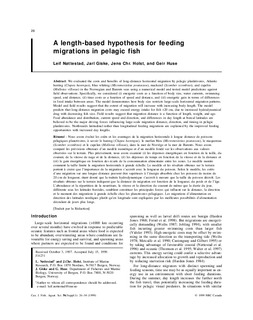A length-based hypothesis for feeding migrations in pelagic fish
Journal article, Peer reviewed

View/
Date
1999Metadata
Show full item recordCollections
- Articles [3012]
Original version
http://dx.doi.org/10.1139/f99-222Abstract
We evaluated the costs and benefits of long-distance horizontal migration by pelagic planktivores, Atlantic
herring (Clupea harengus), blue whiting (Micromesistius poutassou), mackerel (Scomber scombrus), and capelin
(Mallotus villosus) in the Norwegian and Barents seas using a numerical model and tested model predictions against
field observations. Specifically, we considered (i) energetic costs as a function of body size, water currents, swimming
speed, and distance, (ii) time costs as a function of speed and distance, and (iii) energetic gain in terms of differences
in food intake between areas. The model demonstrates how body size restricts large-scale horizontal migration patterns.
Model and field results suggest that the extent of migration will increase with increasing body length. The model
predicts that long-distance migration costs may exceed energy intake for fish <20 cm, due to increased hydrodynamical
drag with decreasing fish size. Field results suggest that migration distance is a function of length, weight, and age.
Food abundance and distribution, current speed and direction, and differences in day length at boreal latitudes are
believed to be the major driving forces influencing large-scale migration distance, direction, and timing in pelagic
planktivores. Northwards latitudinal rather than longitudinal feeding migrations are explained by the improved feeding
opportunities with increased day lengths.